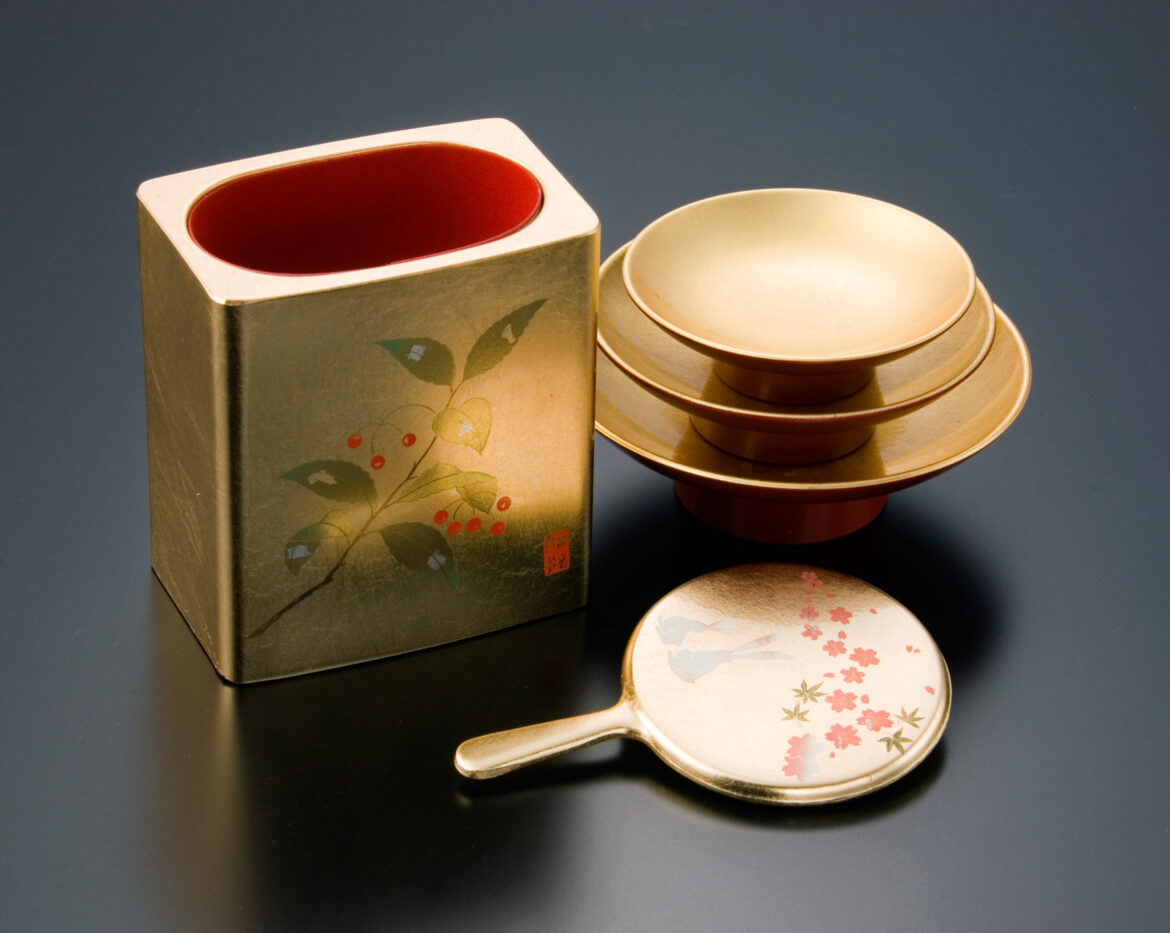Japan is celebrated for its rich cultural heritage, which is beautifully reflected in its diverse array of handmade crafts. For centuries, Japanese artisans have honed their skills, passing down techniques through generations, creating objects of unparalleled beauty and functionality.
One region that stands out for its shining examples of Japanese crafts is that of the Chubu region in the centre of the mainland island of Japan. From the glistening allure of Kanazawa’s gold leaf to the vibrant hues of Arimatsu tie dye, each craft tells a tale of tradition and innovation, with local artisans careful considering and blending strength, durability, and artistic allure in their craftwork.
Join us on a journey through the enchanting world of Japanese crafts, where every creation is a masterpiece in its own right, showcasing the ingenuity and skill of generations past and present, and the enduring spirit of craftsmanship. We’ll begin by introducing three distinct crafts from the Chubu region of Central Japan. Following this, we will offer recommendations on how you can explore these crafts further when you are in Japan, where you can buy them directly, and where to try your hand at creating some yourself at workshops in both Kanazawa and Arimatsu.
Japanese Gold Leaf (Kinpaku)
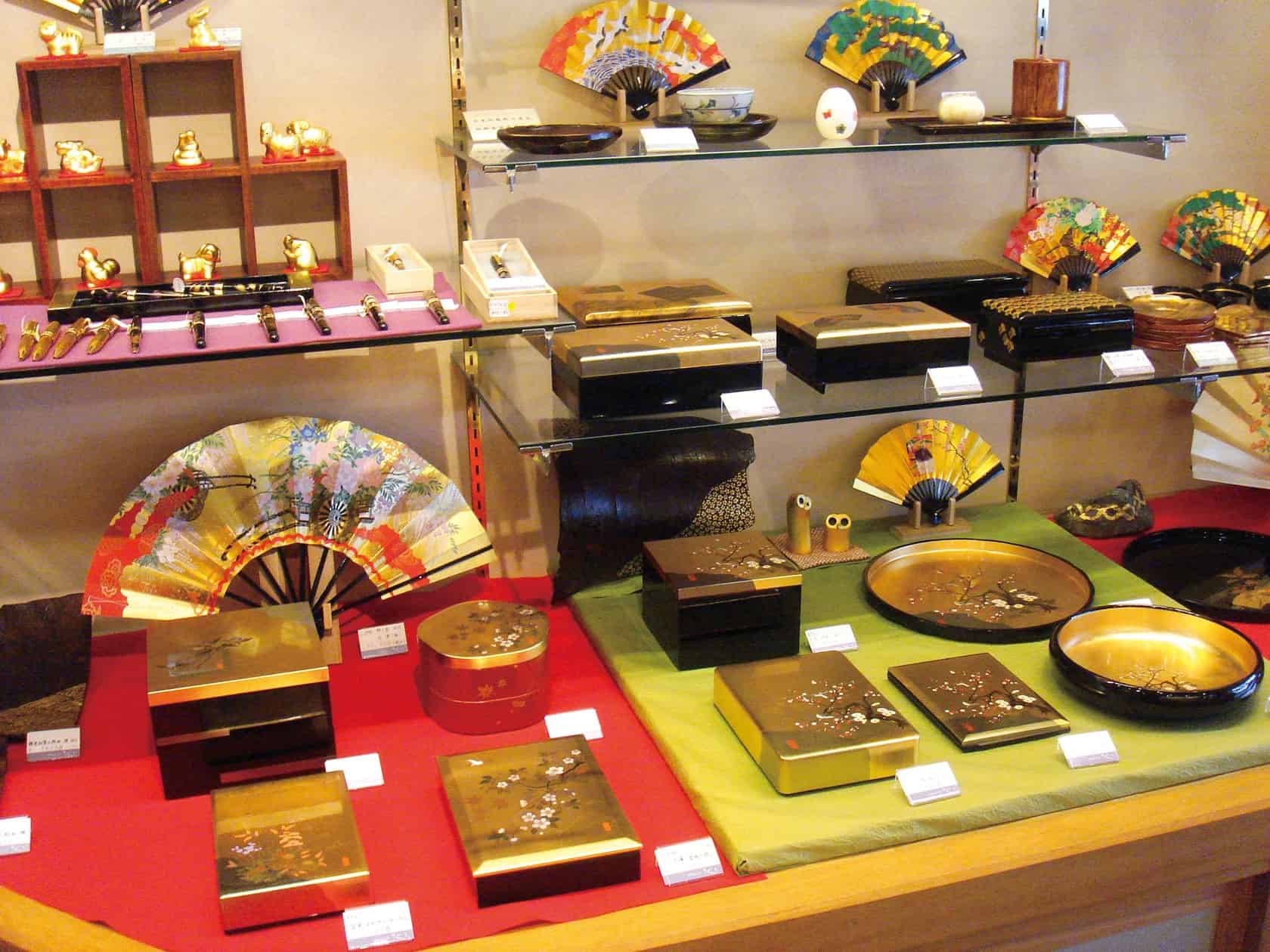
Kanazawa in Ishikawa Prefecture, located on the sea of Japan coast, has long thrived as a center for the production of gold leaf, known as “Kinpaku” in Japanese, and today more than 90 % of Japanese gold leaf is produced in this city. The art form of gold leaf production is said to have found its way to Kanazawa during the Edo period (1603-1868) thanks to skilled artisans from Kyoto. Delicate and precise, gold leaf is meticulously crafted by hammering pure gold into thin sheets, sometimes as thin as a mere 0.0001 millimeters. These fragile sheets then find their purpose in adorning a variety of surfaces such as wood, paper, and ceramics, using traditional techniques.
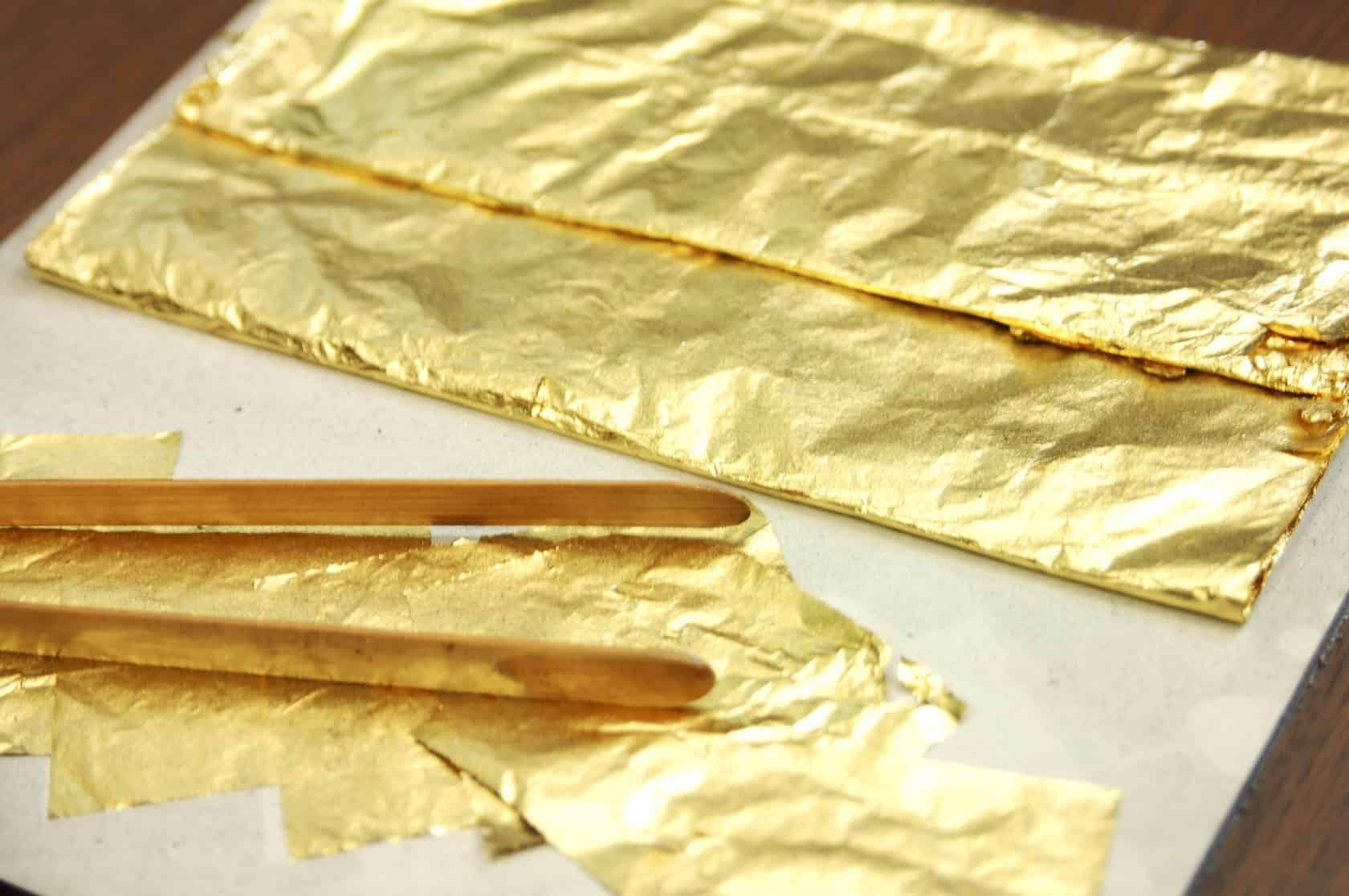
Precision, skill, and patience are all required for gold leaf application, as a single wrong touch can tear the leaf. Artisans start by carefully laying the delicate sheets onto the desired surface, and then smooth them out to create a flawless, shimmering finish. The result is breathtaking: objects adorned with gold leaf exude a sense of opulence and elegance, as can be seen at the nearby Higashi Honganji Kanazawa Betsuin Temple, as well as at temples and palaces across Japan.
Today you will even see gold leaf applied to accessories or food like edible gold leaf soft serve ice cream. If you are visiting Kanazawa, you’ll also get the chance to taste edible gold leaf soft serve ice cream! To find out where you can get gold leaf products and food with gold leaf applied, check our sections below on Kinpaku Gold Leaf Experiences in Kanazawa, and Where to buy Japanese Crafts in Central Japan.
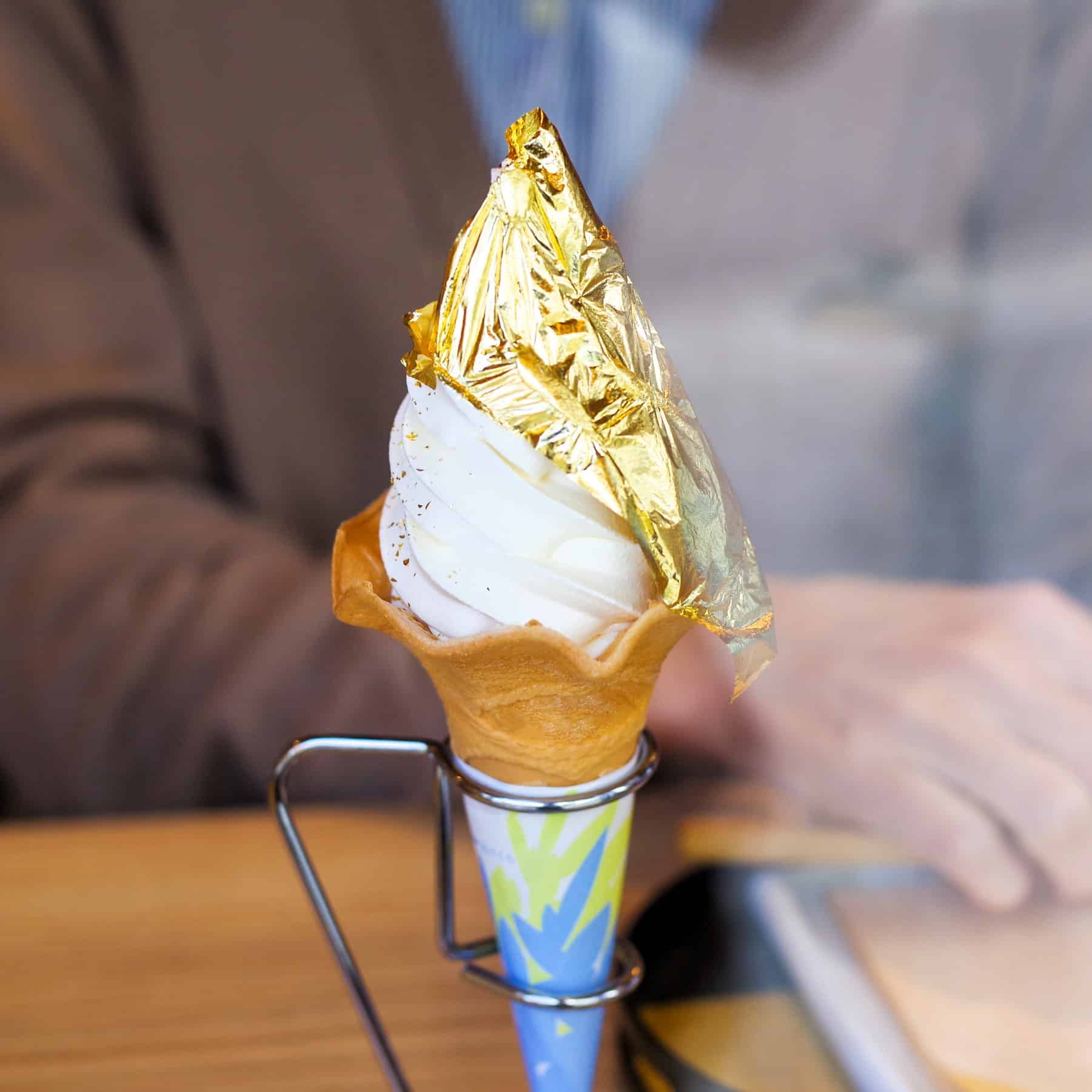
Kaga Yuzen Kimono Dyeing
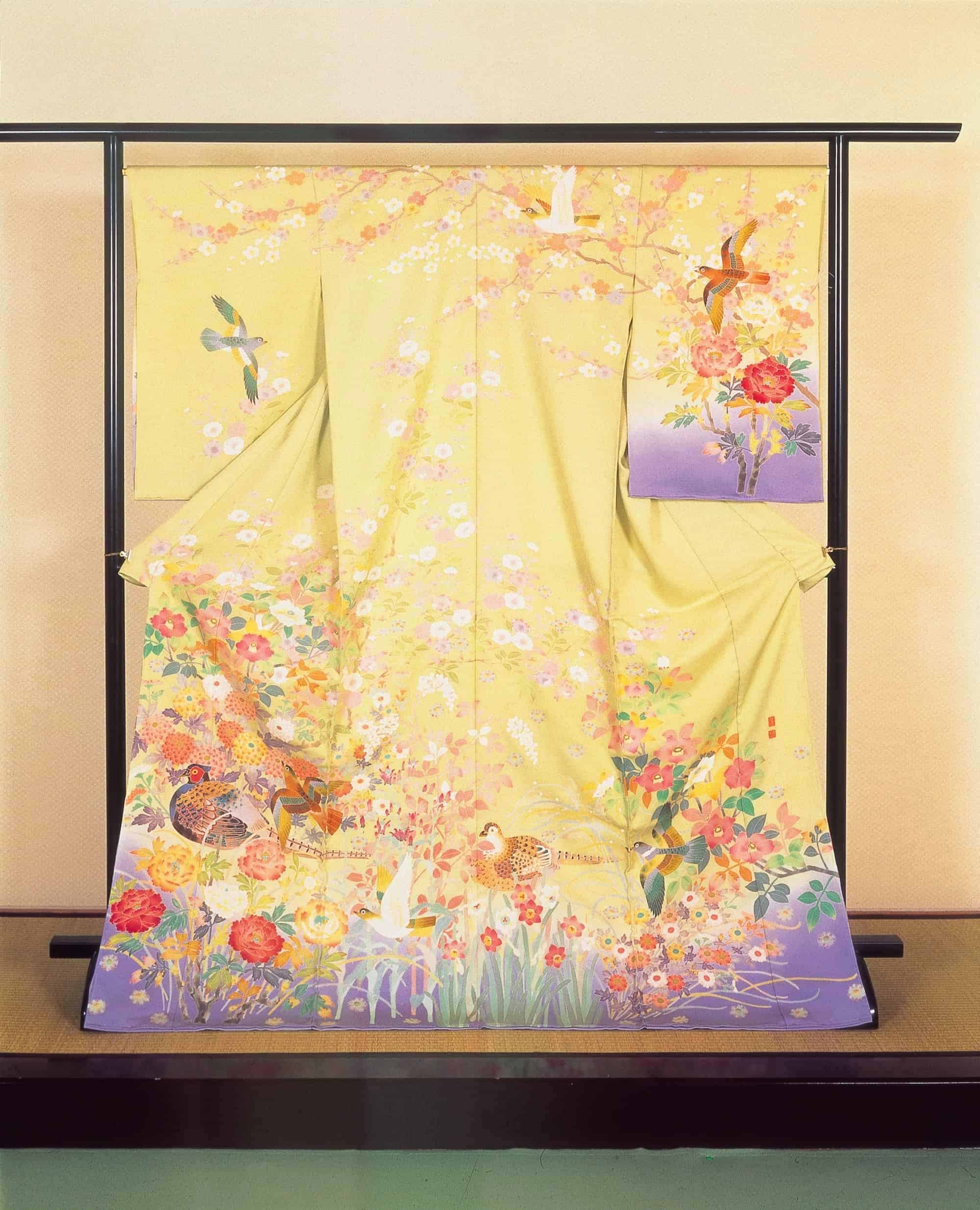
Originating in the Kaga region in the south west of Ishikawa Prefecture, which is also known for its Kutani ware ceramics, Kaga Yuzen Kimono dyeing involves the meticulous application of striking colours such as indigo and crimson onto silk fabric, resulting in luxurious kimono textiles. Kaga Yuzen takes its name from the pioneer of this dyeing technique, Yuzensai Miyazaki (1654 – 1736) who began Yuzen dyeing in Kyoto before settling in Ishikawa. While often compared to Kyoto textiles, Kaga Yuzen stands out with its deep tones, colours and floral designs inspired by the natural beauty of Kanazawa, and distinct from the gold leaf and embroidery patterns found in Kyoto Yuzen textiles.
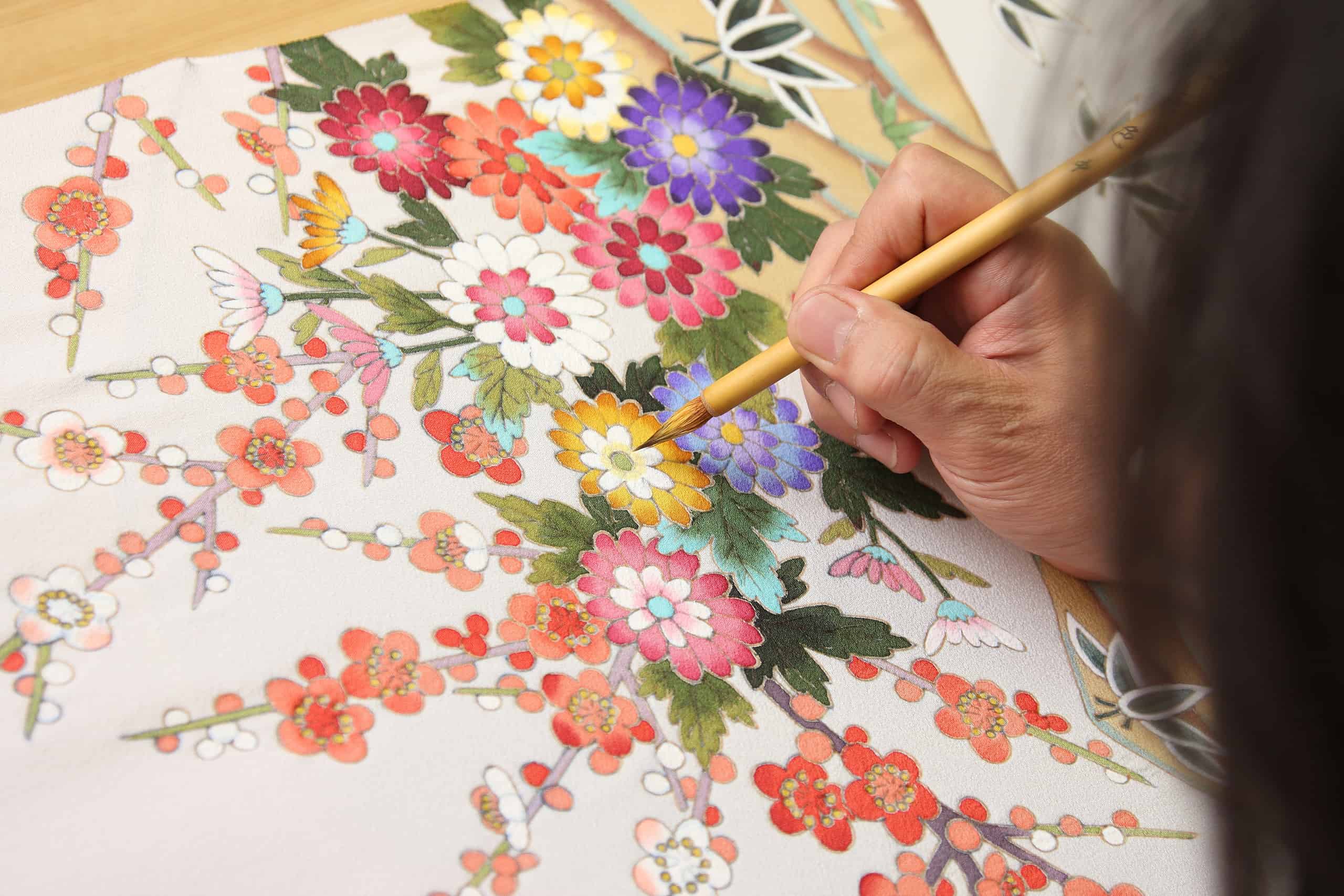
Artisans skilled in Kaga Yuzen kimono dyeing use a variety of techniques, including brush painting and stencil dyeing to achieve stunning designs inspired by nature, folklore, and traditional motifs. These designs capture the essence of nature’s beauty with motifs like flowers, birds, landscapes, and intricate details such as leaves bearing insect bites. Each step of the dyeing process demands precision and careful handling, from preparing the dyes to carefully applying them to the fabric, and as crafting a single piece of hand-dyed Kaga Yuzen requires a significant investment of time and patience, these creations are highly valued.
Arimatsu Narumi Shibori Tie Dyeing
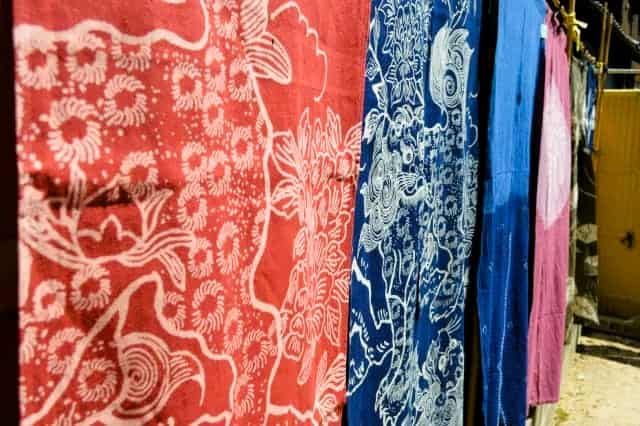
Tie dye, or “Shibori,” is a traditional Japanese dyeing technique that produces intricate patterns by binding, folding, or twisting fabric before dyeing it. Arimatsu and Narumi, now merged into Nagoya City in Aichi Prefecture, were once towns on the old highway route connecting Kyoto and Tokyo, and since the Edo period, Shibori clothes and hand towels made in the towns were sold as souvenirs to travellers on the road.
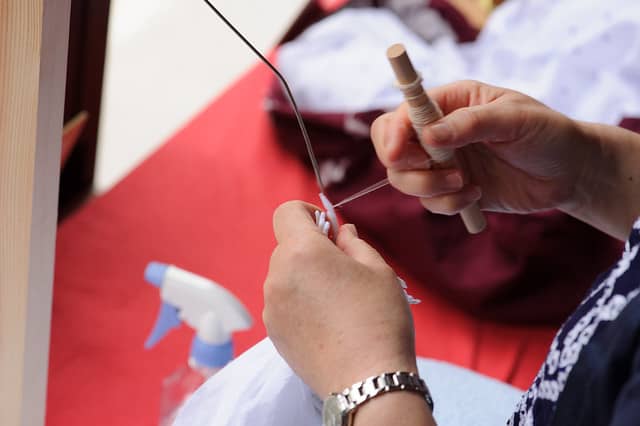
Shibori production started when people from Oita prefecture (in the southern island of Kyushu) arrived in the area to help in the construction of Nagoya castle, bringing with them items and clothes created with Shibori techniques. Inspired by these creations, artisans in Arimatsu and Narumi developed a wide range of complex Shibori techniques, each yielding unique and mesmerising patterns.
The process of Arimatsu Narumi tie dye begins with the preparation of the fabric, which is then meticulously bound or manipulated to create patterns. The sections that are bound resist the dye, resulting in intricate designs with subtle variations in colour and texture, along with distinct polka dot or floral designs. Artisans also traditionally used a characteristic natural indigo dye, which produces rich, deep blues that has became synonymous with Arimatsu Narumi Shibori.
Japanese Crafts Experiences in Central Japan
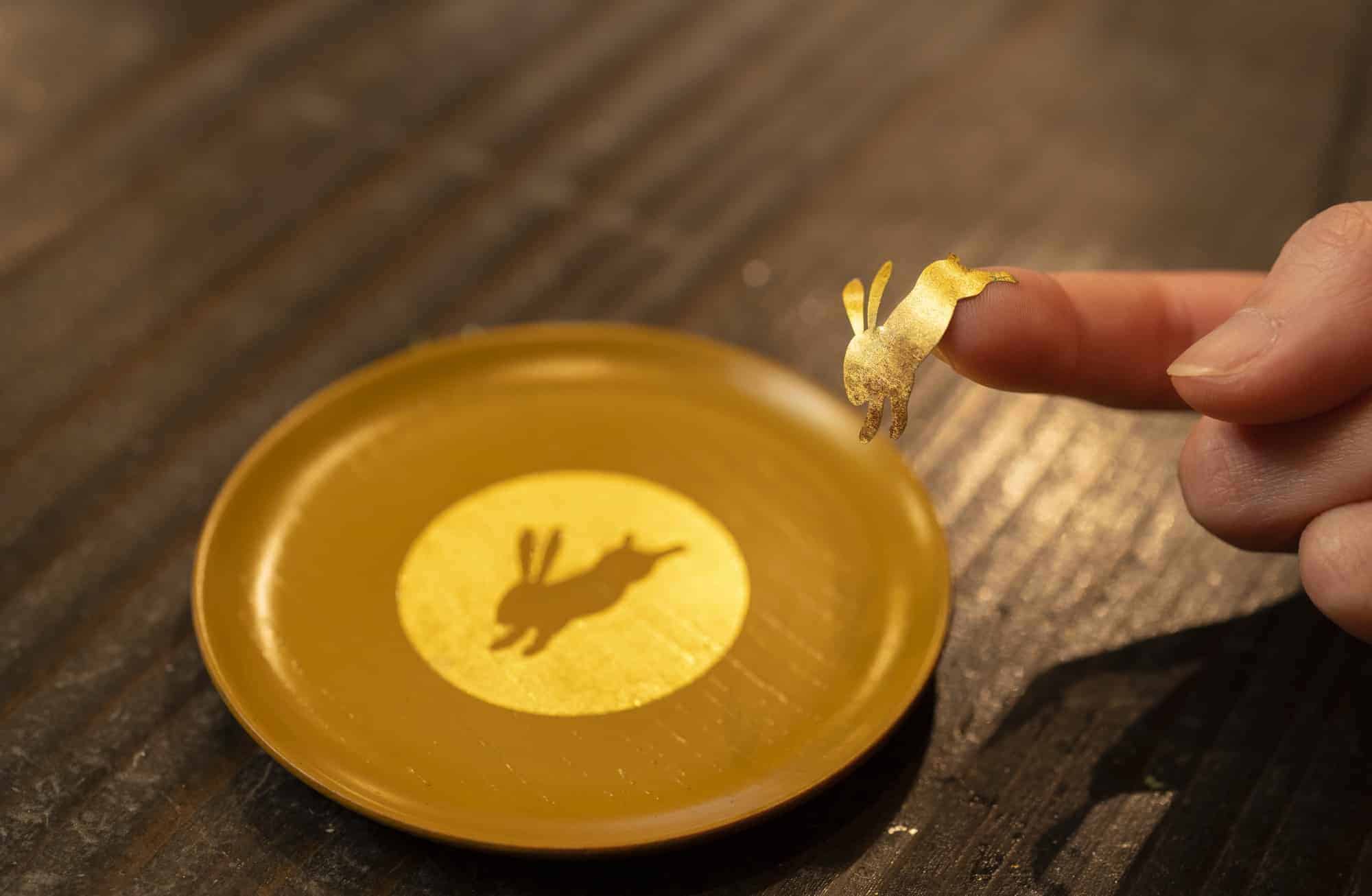
In the heart of Central Japan, one can discover a rich tradition of artisan crafts, where local craftsmen take pride in specialising in one art form, perfecting their skills and passing down their knowledge to future generations. For those planning a trip to Japan or already exploring the country, we suggest exploring Kanazawa City and Arimatsu in Nagoya City, where a myriad of Japanese crafts come to life, offering a unique glimpse into their intricate techniques and fascinating histories.
In the next section, we’ll be introducing museums and facilities celebrating the beauty of these traditional crafts. By visiting, you can immerse yourself in their diverse collections, gain insight into the tools of the trade, and witness skilled artisans in action demonstrating their craft up close. Another way to learn about traditional Japanese crafts is to attend workshops yourself! There are several workshops in the Chubu region (Central Japan) where you can join in the creative process, channel your artistic flair and bring home one-of-a-kind mementos to cherish.
Kinpaku Gold Leaf Experiences in Kanazawa
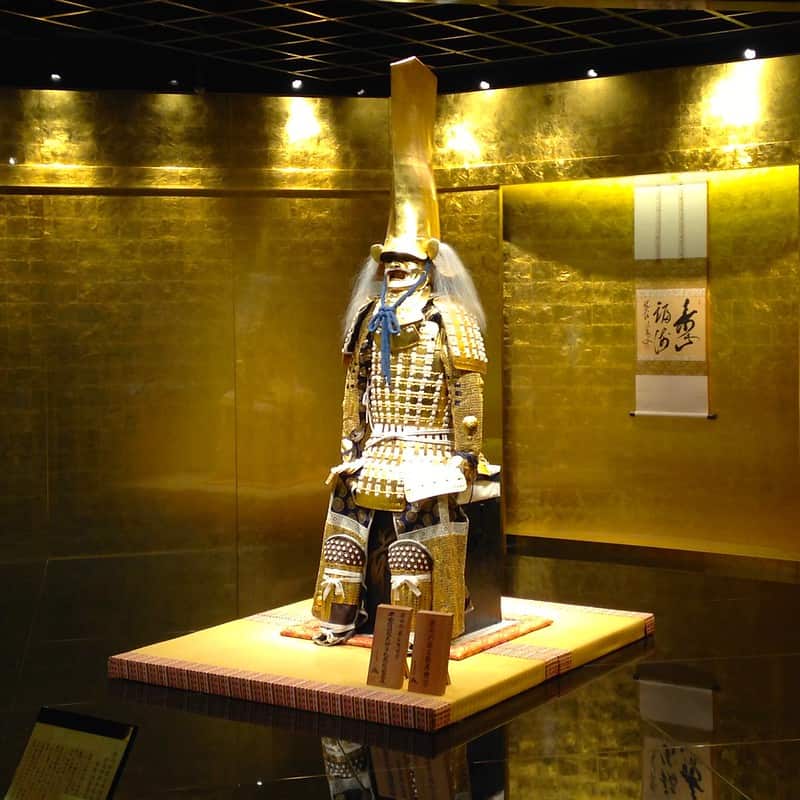
Hakuichi (Hakukokan) Museum
Established in 1975, Hakuichi has become a prominent establishment in Kanazawa, boasting 9 outlets that offer an array of gold leaf items including traditional dining ware, home decor, edible gold leaf and sake, and beauty products. Visitors to their Hakuichi main store museum can enter the Gold-leafed Chamber decorated with 10,000 gold leaves and see a replica of the golden armour and helmet said to have been worn by the founder of the Kaga domain in battle. Upon request, guided tours of the museum that delve into the history and significance of this precious artform are available, and you can see a close-up demonstration of the meticulous gold leaf pounding process by the Hakuichi craftsmen.
Hakuichi Gold Leaf Workshop
The Hakuichi also offers a variety of gold metal leaf workshops tailored for beginners and advanced craft enthusiasts alike. From applying gold leaf to items like plates and boxes at the Master Course level to mastering the art of working with both gold and silver leaf on various objects, including chopsticks at the Wizard Course level – there is something for everyone to discover and create. Another experience that is only available at Hakuichi is the short but satisfying Gold Leaf Transfer where you use the same bamboo tweezer tools as professional craftsmen to transfer gold leaf and place it over a leather-covered woodblock which you can then take home with you.
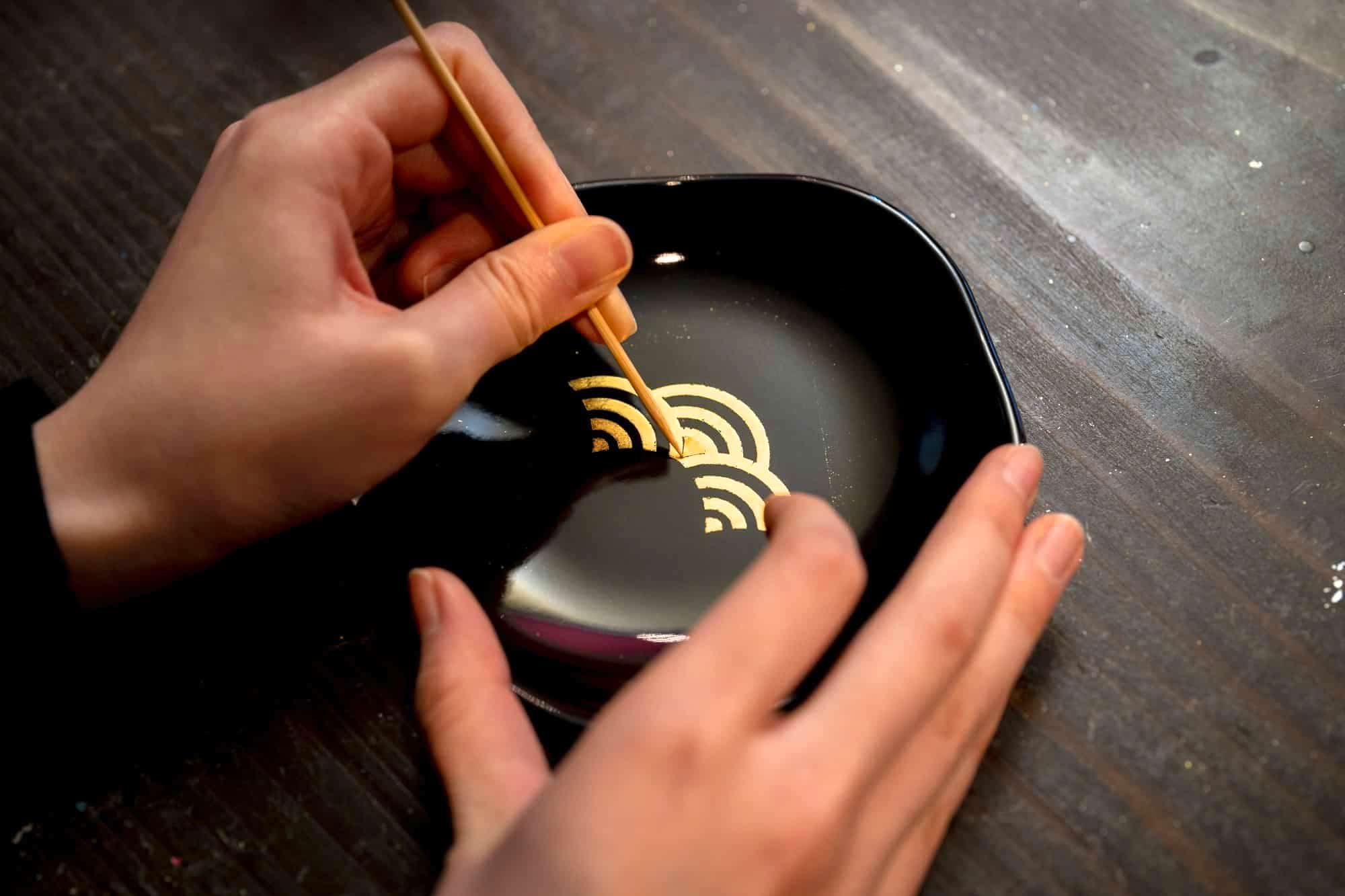
Gold Leaf Sakuda Main Store and Museum
The Sakuda enterprise originally traded as a gold leaf wholesaler, but later expanded their offerings to include decorated handcrafted items in 1970. Since then it has grown to be one of the most renowned brands in Kanazawa for gold leaf embellished goods. The flagship store offers a diverse range of decorated products and accessories, the option to savour tea with glints of edible gold, and provides visitors with an opportunity to view the manufacturing process during factory area tours. A notable highlight not to be overlooked during your visit is their lavatory, lavishly enveloped in gold and platinum leaf!
Gold Leaf Sakuda Workshop
You can discover the joy of adorning everyday items with gold yourself by participating in one of their hands on workshops. They have four sessions daily lasting 60 minutes each, where you can select from an array of objects to decorate like chopsticks, jewelry boxes, and compact mirrors. Due to the popularity of these workshops, it is advisable to secure your spot in advance by booking through their official website. Also, attending a workshop entitles you to a 10% discount on purchase at the Gold Leaf Sakuda Main store or Machiya Store with the exception of a few products.
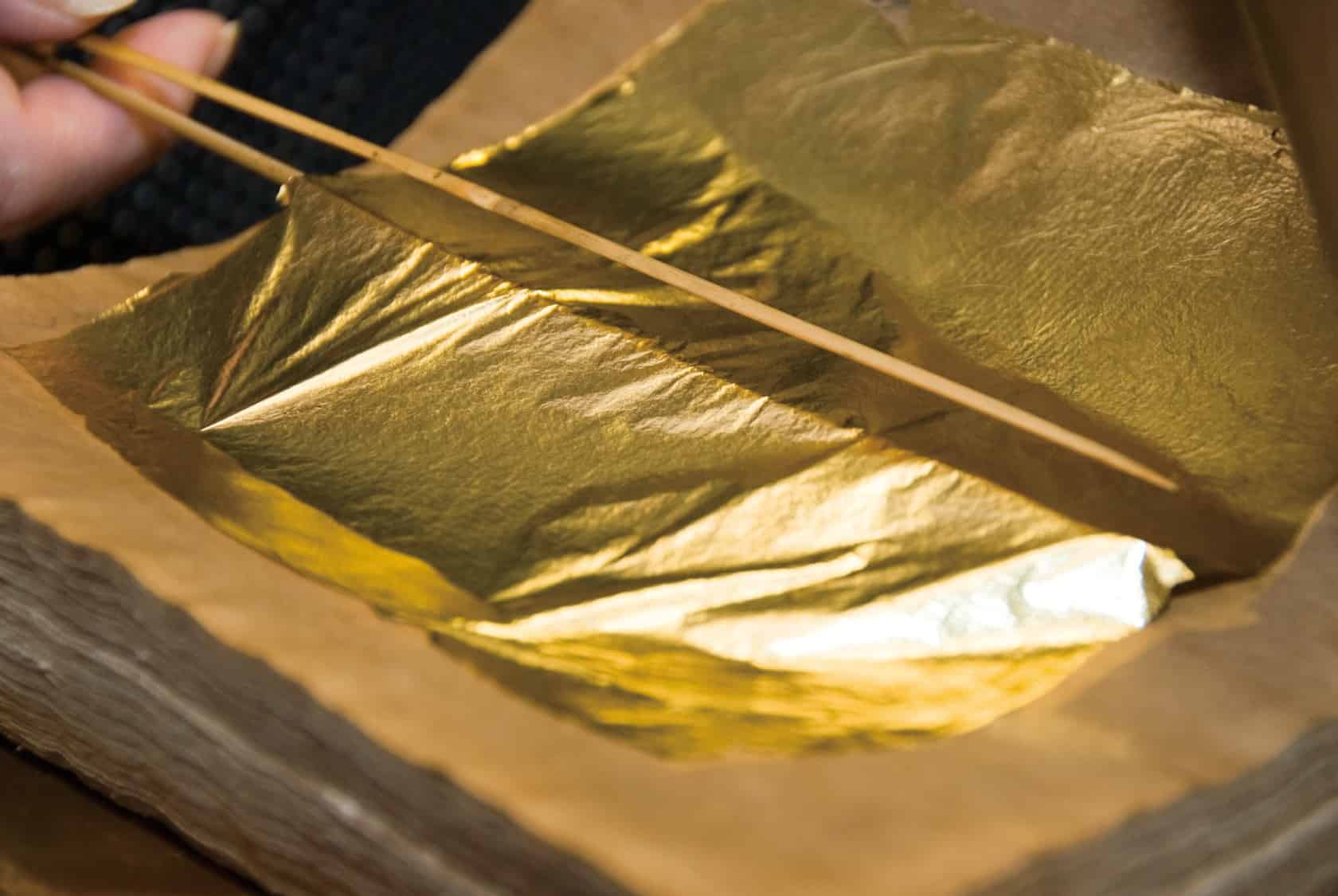
Kanazawa Yasue Gold Leaf Museum
Established in 1974, the Kanazawa Yasue Gold Leaf Museum offers a comprehensive look into the history of gold leaf craftsmanship with a diverse collection of approximately 300 pieces and tools for making this vivid art form spanning from the pre-Edo period (before 1603) to the modern era. The museum was founded by the renowned gold leaf artisan, Yasue Takaaki (1898-1997), who had a passion for preserving and passing on the profound tradition and heritage of gold leaf artisans.
When visiting the museum, you will find most exhibits to have English explanations. While small, the museum collection is diverse comprising of folding screens, hanging scrolls, Buddhist altars, Noh costumes, and lacquerware, all adorned with exquisite gold leaf decorations. You’ll also have the chance to witness skilled artisans demonstrate their craft, showcasing techniques like preparing special washi paper where gold is pounded and then delicately incorporated between the pages.
Kaga Yuzen Experiences in Kanazawa
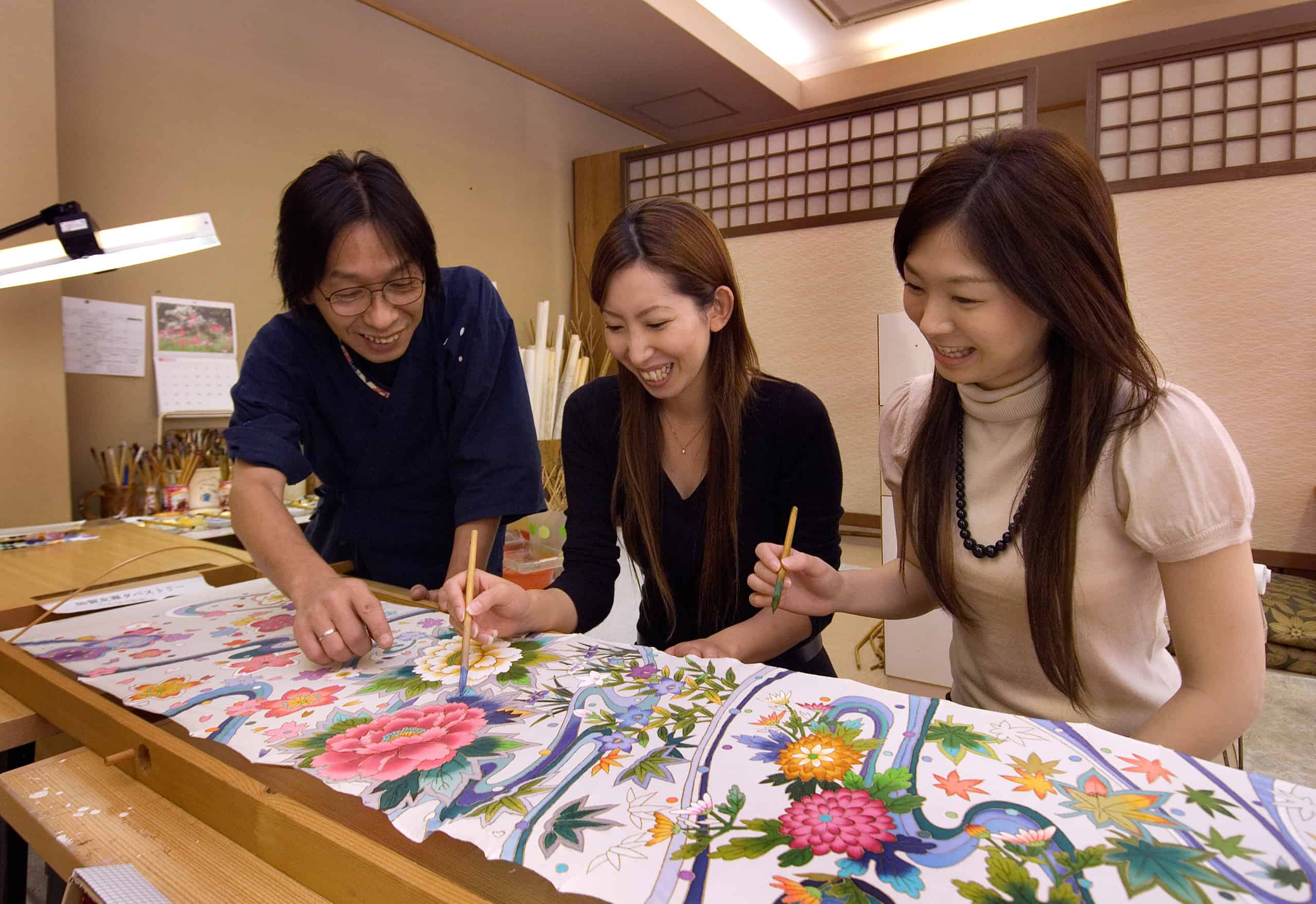
Kaga-Yuzen Kimono Center
Located in proximity to Kanazawa Castle and the beautiful Kenrokuen Garden is the Kaga-Yuzen Kimono Centre. Established with a mission to safeguard this beloved cultural legacy, the center proudly displays a collection of exquisite Kaga-Yuzen kimonos crafted by renowned artisans, providing a fascinating window into the intricate realm of Kimono artistry. At the centre, all visitors are encouraged to join demonstrations where artisans showcase the Kaga Yuzen dyeing process.
Kaga-Yuzen Kimono Centre Workshop
The Kaga Yuzen Kimono Centre offers engaging hands-on workshops where you can learn to personalise a handkerchief or tote bag with your own dyed designs, and then take home your masterpiece as a cherished keepsake. While at the centre, take the opportunity to try on an authentic Kaga-Yuzen Kimono yourself, and browse through a selection of Kimonos as well as exquisitely dyed products available for purchase at the store.
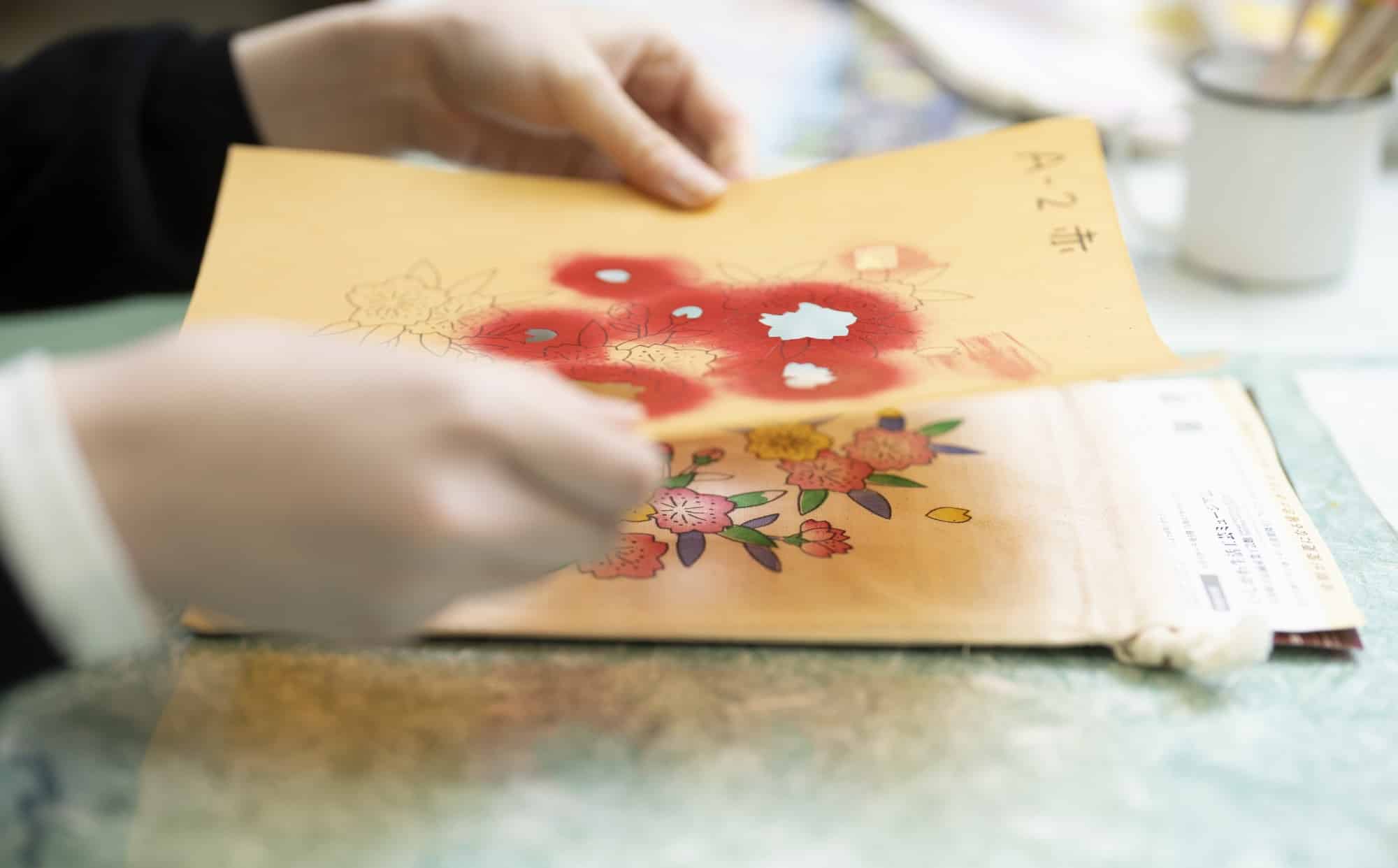
Akaneya Archive Gallery – Kaga Yuzen Kimono Dye Studio “Akaneya”
Nestled in a charming historic residence about 5 minutes from the 21st Century Museum of Contemporary Art, Akaneya has been in business for 120 years in the traditional Satomicho district. While keeping the spirit of the Kaga Yuzen tradition, Akaneya embraces innovation and modern aesthetics, and contributes new designs to ensure the legacy thrives for generations to come.
Akaneya Kaga Yuzen Workshop
Offering a hands-on experience, at Akaneya’s Kaga Yuzen Workshop participants can explore the art of craftsmanship and release their creativity. Working inside their gallery, you first get to select from a diverse range of base materials such as tote bags, Furoshiki wrapping clothes, and hand towels. Next, you’ll craft a unique design using an assortment of stencil patterns, blending them harmoniously with the five classic hues characteristic of Kaga Yuzen dyeing.
Arimatsu Shibori Tie Dyeing Experiences in Arimatsu
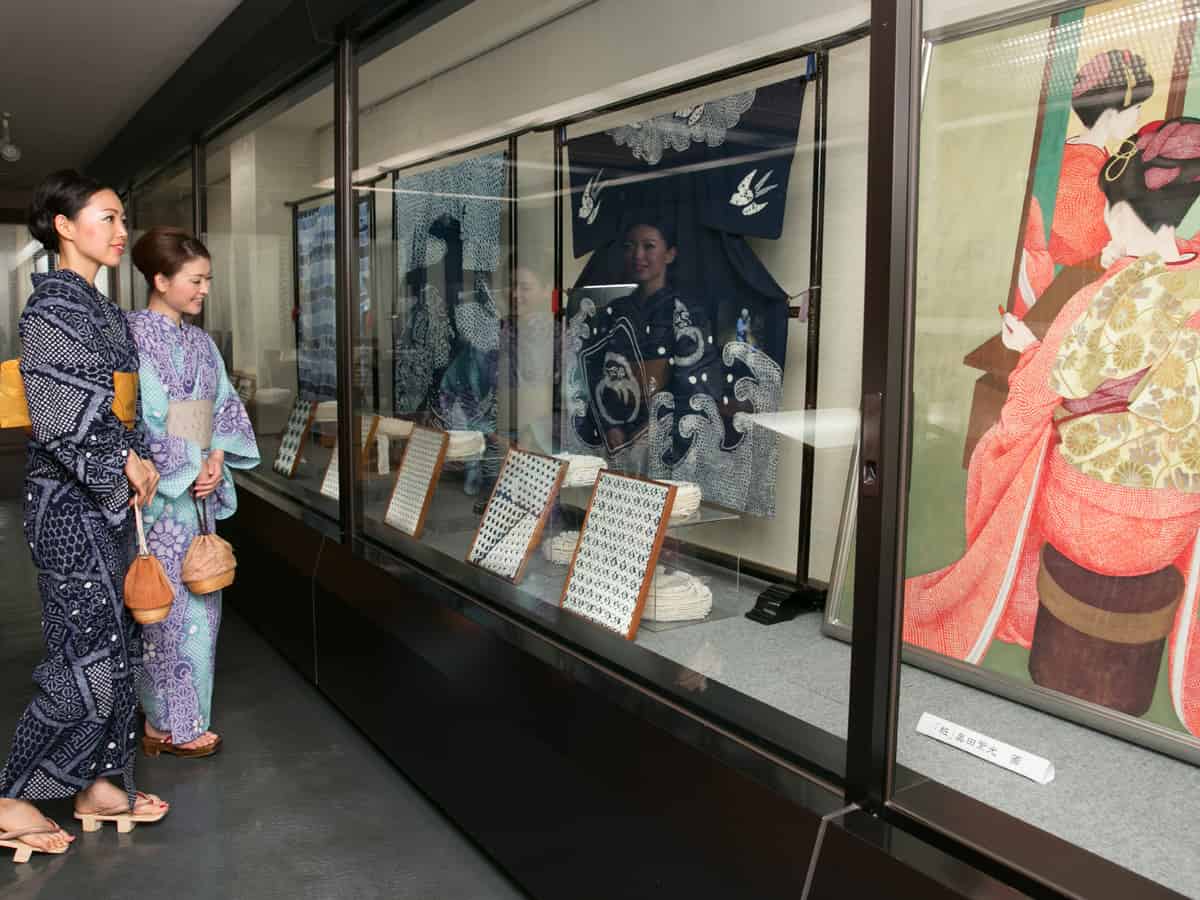
Arimatsu Narumi Tie-Dyeing Museum
The Shibori Kaikan also known as the Arimatsu Narumi Tie-Dyeing Museum is a museum where you can delve into over four centuries of Shibori craftsmanship. Visitors can not only learn about its rich heritage through collections of historical items but also admire and acquire stunning pieces. The museum boasts an impressive array of Shibori products, including handkerchiefs, scarves, tablecloths, bags, noren (Japanese small curtains), yukata (casual summer kimono) and more, all available for purchase at the onsite shop.
Arimatsu Narumi Tie-Dyeing Workshop
Captivating demonstrations showcasing the art of Shibori tie-dyeing are held throughout the day outside of lunch hours at the Tie Dyeing Museum, with artisans who are willing to provide detailed explanations of their craft. The museum also offers the unique opportunity to partake in Shibori dyeing firsthand. You can secure a spot by making a reservation in advance, and create your own Shibori design on a hand towel, which you can take home on the same day.
Shibori Tie-Dye Workshop and Arimatsu City Tour in English
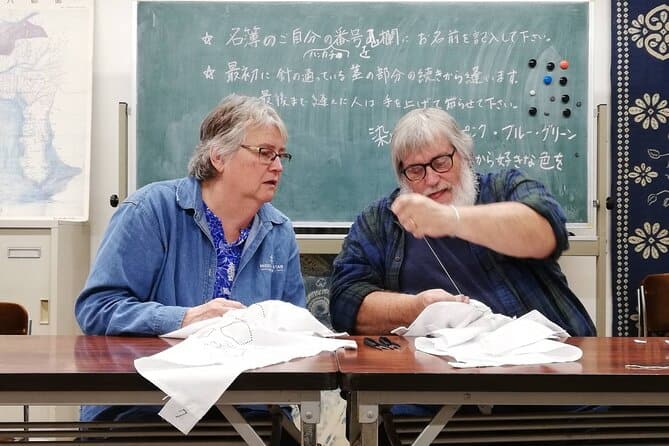
With the Shibori Tie-Dye Workshop and Arimatsu City Tour, you’ll have a rare opportunity to explore the world of Arimatsu Narumi Shibori tie-dye in English. The tour allows you to delve into the art of Shibori tie-dye while exploring the historic city of Arimatsu. You’ll be able to create your own Shibori masterpiece and venture on a guided walking tour introducing the Edo period (1603-1868) architecture in Arimatsu as well as visiting the renowned Arimatsu Narumi Tie-Dyeing Museum. Witness tie-dye demonstrations, explore historical exhibits, and discover exquisite Shibori products for sale during this enriching journey.
The Arimatsu Shibori Festival

Marking what will be its 40th anniversary this year, the Arimatsu Shibori Festival is a much-celebrated event that takes place each year in Arimatsu. This vibrant festival is a time-honoured tradition that unites individuals from various walks of life and ages in a shared appreciation of the Arimatsu Shibori artisanal culture.
Attendees can look forward to a vibrant array of tie-dye and Shibori products on sale, and captivating demonstrations of tie-dyeing techniques, originating over 400 years ago and consisting of more than a hundred intricate steps carefully preserved across generations. By joining the festival, you’ll also be able to engage in tie-dyeing lessons against the picturesque backdrop of the historic Old Tokaido Road.
Where to buy Japanese Crafts in Central Japan
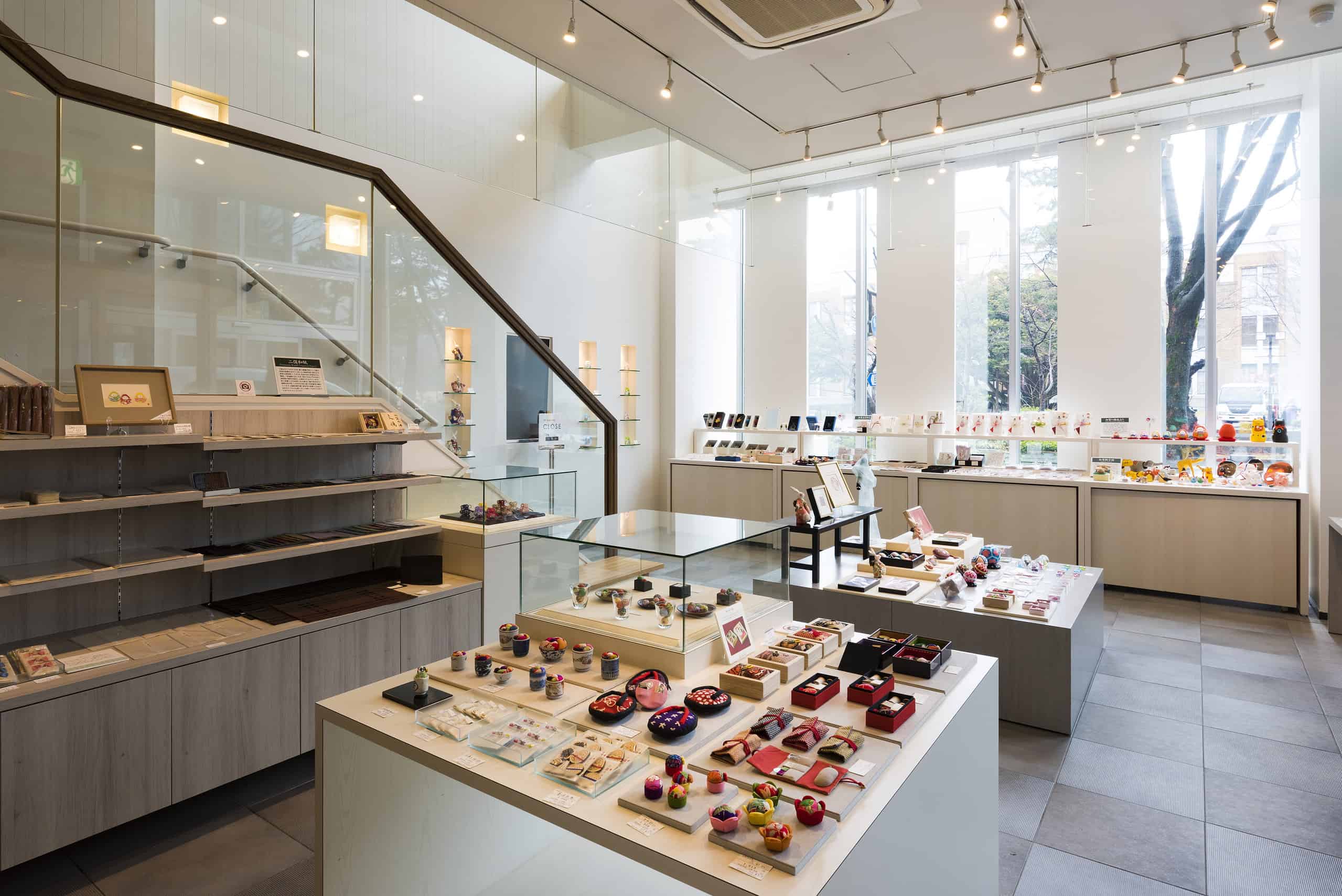
Exploring the Chubu region (Central Japan) provides a plethora of opportunities to acquire authentic Japanese crafts. For instance, seekers of Kaga Yuzen Kimonos can find them at the Kaga-Yuzen Kimono Center as highlighted earlier. Those drawn to Kinpaku gold leaf products can indulge in shopping at Hakuichi or Gold Leaf Sakuda, both previously mentioned. Beyond these establishments there are several other stores where you can purchase Japanese crafts in Central Japan, spanning from Kanazawa on the sea of Japan coast in the north to Aichi Prefecture on the Pacific coast in the south.
Kanazawa Crafts Hirosaka in Kanazawa
There are over 20 rare traditional Japanese crafts in Kanazawa, and the Kanazawa Crafts Hirosaka store brings all these crafts created by local artists and skilled craftspeople together under one roof. Among the traditional crafts you’ll find there are Kanazawa Gold Leaf, Kaga Yuzen, and Kutani porcelain, as well as reasonably priced lesser known handicrafts such as Kaga fishing flies, Paulownia handicrafts, and Kaga Mizuhiki which are gift wrapping strings.
On the ground floor level, the shop offers an array of products that cater to various tastes, ranging from exquisite gems to everyday essentials. At the rotating exhibit corner, new pieces from up-and-coming artisans are showcased every four weeks, adding a fresh perspective to the space. Then moving to the second floor (first floor in UK and Europe), you’ll discover a gallery showcasing modern masterpieces crafted by artists dedicated to preserving Kanazawa’s rich heritage of traditional arts.
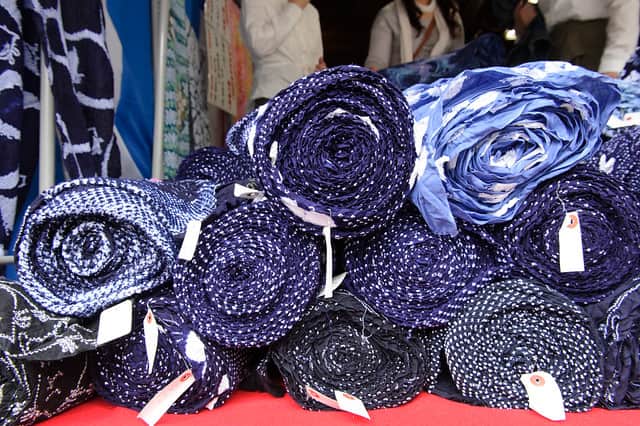
Arimatsu Shibori Hisada in Arimatsu
Dating back more than four centuries, the legacy of Arimatsu Shibori Hisada traces its origins to the inception of Shibori tie dyeing. Throughout the passage of time, these skilled artisans have refined their craft, enhancing the production methods and developing upwards of 100 distinctive techniques. Today, Arimatsu Shibori Hisada’s commitment continues to lie in the constant innovation of designs that resonate with contemporary tastes, all while upholding the time-honoured traditions of the craft.
Entering the Arimatsu shop, one will encounter a wide array of Shibori goods, from classic Furisode (formal long-sleeved Kimono), and handkerchiefs to modern shirts and neckties for men, and stylish dresses and scarves for women. Expanding beyond attire, Arimatsu Shibori Hisada now offers interior decor like tablecloths and cushion covers, as well as accessories like masks and fans.
Store List of where to buy Japanese Crafts in Central Japan

We include here the stores we have covered above plus a few others that we recommend visiting. You can find more information and store details by clicking through the website links below.
For Gold Leaf Products in Kanazawa (Ishikawa Prefecture):
- Gold Leaf Sakuda: https://goldleaf-sakuda.jp/en/shoppingguide/
- Hakuichi: https://enkanazawa.hakuichi.co.jp/shop/index.php
- Imai Kinpaku: www.kinpaku.co.jp/english/shop/index.html
Also, while in Kanazawa you’ll be able to get edible gold leaf confectionery at several shops including the ones above and even order the famous soft serve ice cream with gold leaf as pictured below.

For Kaga Yuzen Products in Kanazawa (Ishikawa Prefecture):
- Kaga-Yuzen Kimono Center: http://www.kagayuzen.or.jp/hall_en/
- Takeya: http://www.kanazawa-takeya.co.jp/shop.htm (website in Japanese)
For most traditional Japanese Crafts from Kanazawa (Ishikawa Prefecture):
- Kanazawa Crafts Hirosaka: https://www.crafts-hirosaka.jp/index_e.html
For Arimatsu Shibori Products in Arimatsu (Nagoya City in Aichi Prefecture):
- Arimatsu Narumi Tie-Dyeing Museum: Arimatsu Narumi Tie-Dyeing Museum
- Arimatsu Shibori Hisada: https://www.shibori-hisada.com/english/
- Aya Irodori: https://www.aya-irodori.com/ (website in Japanese)
As we wrap up our journey delving into the realm of Japanese artistry, we hope that this piece has enlightened you on the intricate crafts and cultural heritage of Kinpaku Gold Leaf, Kaga Yuzen Kimono dyeing, and Arimatsu Shibori dyeing. For those captivated by the allure of Japanese craftsmanship and eager to learn more and try these crafts during a visit to Japan, we believe that our guidance on must-visit locations and engaging workshops across Central Japan will prove valuable.
Should you have any questions or feedback, please don’t hesitate to leave them in the comments section. For those seeking other exciting places to explore in Japan, we suggest visiting our travel page for more destination ideas. Additionally, to delve deeper into the rich culture and history of Japan’s Chubu region, feel free to explore our articles on Japanese Pottery and the Japanese Swordsmiths of Seki.
Finally if you are in search of accommodations in Nagoya, which is a convenient location for Central Japan, we have curated a list of highly recommended hotels for your convenience.
Note: All the information and details are correct at the time of publishing. We would recommend checking each museum, workshop or store website for the latest information.

